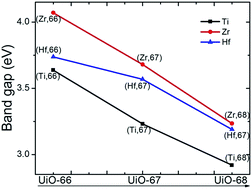Computational exploration of newly synthesized zirconium metal–organic frameworks UiO-66, -67, -68 and analogues†‡
Abstract
One of the major weaknesses of metal–organic framework (MOF) materials is their rather low thermal, hydrothermal, and chemical stabilities. Identification of stable and solvent resistant MOF materials will be key to their real world utilization. Recently, Lillerud and coworkers reported the synthesis of a new class of Zr MOF materials. These materials have very high surface area and exceptional thermal stability, are resistant to water and some solvents, acids, bases, and remain crystalline at high pressure. The newly synthesized Zr metal–organic frameworks (UiO-66, -67, and -68) as well as analogues substituting Ti and Hf for Zr, are explored using density functional theory calculations. The crystal structure, phase stability, bulk modulus, electronic structure, formation enthalpies, powder X-ray diffraction, chemical bonding, and optical properties are studied. We find bulk moduli of 36.6, 22.1, and 14.8 GPa for UiO-66, -67, and -68 respectively. As the linkers are extended, the bulk modulus drops. The highest occupied crystal orbital to lowest unoccupied crystal orbital gaps range from 2.9 to 4.1 eV. The compounds have similar electronic structure properties. Experimental powder X-ray diffraction patterns compare well with simulation. The large formation enthalpies (−40 to −90 kJ mol−1) for the series indicate high stability. This is consistent with the fact that these materials have very high decomposition temperatures. A detailed analysis of chemical bonding is carried out. Potential applications for these new materials include organic semiconducting devices such as field-effect transistors, solar cells, and organic light-emitting devices. We hope that the present study will stimulate research on UiO-based photocatalysis and will open new perspectives for the development of photocatalysts for water splitting and CO2 reduction. The large surface areas also make these materials good candidates for gas adsorption, storage, and separation.


 Please wait while we load your content...
Please wait while we load your content...